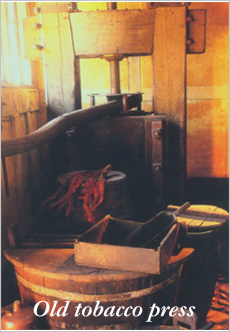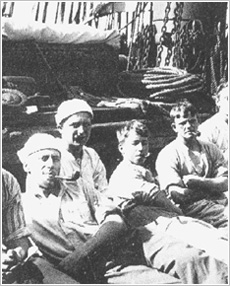When and where the first flake tobacco was produced is uncertain, but what is known for a fact is that pressed tobacco was invented to solve a major problem at the time in a country with great seafaring traditions. Turn back time some 300-400 years, and you find that pipe smoking was the most common way to enjoy tobacco – and seafarers were among its most avid advocates.
Among seamen in particular, pipe smoking was highly esteemed – but there were problems with storing the tobacco. Way back at the beginning of the history of tobacco, spun and loose tobaccos were the forms most commonly found. But on long sea voyages the tobacco would become dry and the taste deteriorated. Many seamen tried moistening the tobacco with water to prevent this problem, while others tried packing the tobacco in canvas and sealing it with liquid tar to retain the moistness. No doubt this did help to retain moistness, but it was found that when the tobacco was smoked it had a very strong taste of tar. Compared with the tobacco we know today, smoking it must have been quite an unpleasant experience and would certainly have given nowhere near the pleasure a good tobacco gives. Others experimented by boiling water and sugar to form brine that was then poured over the tobacco. This method gave the seamen tobacco that tasted better and retained its moisture longer. The sugar brine made the tobacco “fatty” and acted as a binder when the tobacco was pressed together with the hands, which reduced the surface area so that the tobacco did not dry out as quickly. At the same time, tobacco pressed in this way took up less space, which was a great advantage on a cramped ship. Thus sugar brine helped to keep the tobacco moist for a longer period of time.

The experience thus gained eventually came to the notice of the tobacco factories, and after numerous failed attempts the first blocks of pressed tobacco were eventually ready for market. It is not known which factory or country can take the credit for the “invention” of flake tobacco, but seamen were now able to buy ready-pressed tobacco – and pressed substantially harder than they could manage by hand. So seamen finally had a tobacco that dried out much more slowly, and what had started out as a problem and an irritation to seamen eventually culminated in a new type of tobacco – pressed tobacco.
Seamen everywhere quickly got used to the new type of pressed tobacco and soon refined a method of filling the pipe with it. In fact, the right method is really very simple – once you know how to do it.
When ships were at sea the seamen had to follow the captain's rules about smoking on board, which meant that smoking was onlyallowed in a certain part of the ship and only with the captain's permission (today we are familiar with the no smoking concept, but in those days the rules were introduced to prevent the wooden ships cathing fire). When a seaman was granted permission to smoke, he quickly fetched his pipe and tobacco, went astern and the ritual would begin. The tobacco block was placed on the cutting board and with his knife he would cut slices of tobacco as thinly as possible. The seamen called a slice a ”flake” (today we are all familiar with the term “Navy Cut”, which actually dates from the birth of the flake). Once the appropriate number of “flakes” had been cut, the tobacco was folded down the middle and bent into a U shape, taking great care not to loosen the tobacco. Now the pipe could be filled with the tobacco.

Here I will just stop for a moment to create the right mood. Naturally, it was important for the seaman to enjoy a good pipe of tobacco, but equally important was the camaraderie with his colleagues that always accompanied a good smoke. When the captain gave permission to smoke, fellow seamen from all sections of the ship would gather and the ritual of cutting the tobacco and filling the pipe became more than just a seaman's experience – it was a social event. While enjoying the tobacco, important topics would be discussed and – another significant element in those days – snippets of news would be exchanged between the seamen. News passed on during a tobacco session would quickly spread throughout the ship. There can be no doubt that officers, too, used these “smoking breaks” as a way of spreading information to the crew of the ship.
However, pipe smoking also served another very important function. Imagine being on board a large sailing ship in a raging storm. For days the wind has been ripping at the sails and massive waves are breaking over the decks. The entire crew are fighting for their lives against the forces of nature.
The stress building up in each man has to be dealt with at some point – and this is where pipe smoking comes in. When the storm finally abates and the captain again gives permission to smoke, it is not just the act of smoking that is important. Filling the pipe, lighting it, slowly exhaling the smoke… the pure satisfaction and enjoyment of a properly filled pipe were all part of the pleasures of pipe smoking. Another important aspect of pipe smoking was the psychological effect. The seamen would stand shoulder to shoulder, each with his pipe, and talk among themselves – many would take the opportunity to gather their thoughts, reflect on the dangerous situation they had just been through and let the stress slowly subside with every puff on the pipe. With only a slight stretch of the imagination, you could say that pipe smoking can in some instances be considered as “psychological first aid”, or at least a means whereby one's psychological balance can be regained. Many will have used this moment of camaraderie to talk out their sorrows and concerns, and the others will certainly have rallied round and tried to help where they could. In any case, many topics were doubtless mulled over in this way, and simply being able to talk about problems and sorrows with others must have been a great help. At other times the atmosphere will have been more relaxed and congenial, and then the pipe smokers probably told jokes and poked good-natured fun at one another. Who has not experienced the cheerful atmosphere that so often prevails when smokers gather together?
In this stressful day and age, a pipe would be a good way for many people to counter some of the stress that builds up during the course of the day. To fill a pipe, light it, and lean back in a comfortable chair in peace and quiet is an excellent way to gather your thoughts again – and a pipe full of flake tobacco is a fine way to end the day.